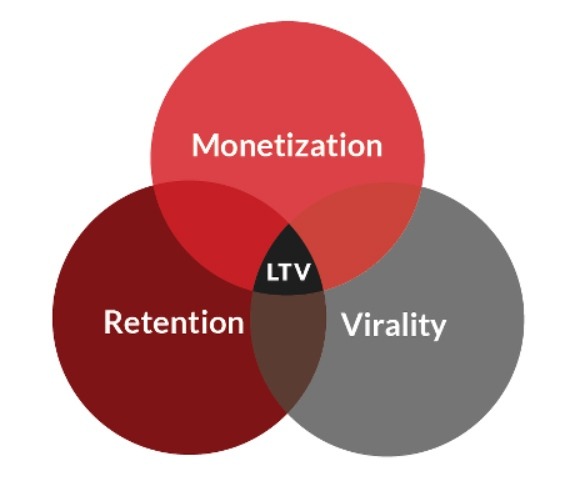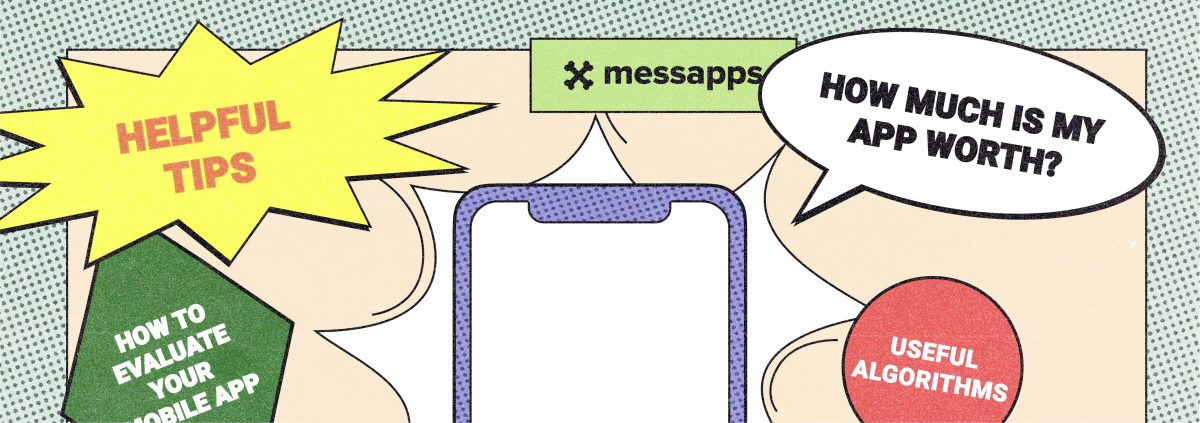Working on over hundreds of apps User Lifetime Value (LTV) is the measure of a user’s worth over a period of time. It helps determine the quality of your users. Even if a user doesn’t prove his value to the company directly by spending money on in-app purchases, they could still be of high-value if they share the app with their friends, spreading the word.
LTV provides insight into wherein a user lifecycle the most value is being created. This metric will help you optimize your acquisition strategy, targeting users that give-back.
Components of LTV
LTV focuses on specific segments of an app’s user base to analyze unique patterns of behavior that are separated by time, rather than providing an overall metric which deals with the entire user base. Due to this factor, LTV is a lot more complex than simply measuring average revenue per user (ARPU). Nevertheless, ARPU plays an essential role when calculating LTV. Aside from the ARPU, there are three main components that influence LTV: retention, monetization, and virality.

Source: Apptamin
Retention
Retention is the level of engagement a user has with your app over time. Essentially it’s how much time they spend taking advantage of the app’s functions over the length of an average customer lifecycle. When calculating retention, you measure how frequently your customers come back for more after installation.
Monetization
How much a user invests in the app. Investments can be in the form of ad-impressions (any time an ad gets fetched from its source, not taking into account whether it gets clicked on or not), subscriptions, or in-app purchases.
Virality
“A phenomenon in which users acquire other users, usually through some referral mechanism built into the product on offer” (en.oxforddictionaries.com). This accrual of a user by a user creates value. The three main referral mechanisms include social media sharing, word of mouth, and email.
How to Deal with LTV Fluctuations
Here are some likely scenarios that can occur in your company taking the LTV into account:
- Revenue is flying but LTV is sinking.
Due to the heavy marketing investment, people are acknowledging your app. They see it everywhere and are giving it a fair chance. But upon using the app, their interest falters, it’s just not that engaging. The app’s flame is being spread just as fast as it’s being extinguished. Cash is burning and eventually, your revenue will dry up after your marketing efforts slow down. Figure out how to increase user retention and engagement.
- Revenue and LTV are both sinking.
Your marketing efforts are poor, as is your engagement and retention. Users are no longer coming and the ones that are still involved are most likely set to leave.
- Both revenue and LTV are flying.
Users find your app engaging and are not weary to stick around. Your users are content with the environment you’ve created for them. Ad-impressions are on the rise, people are talking, money is coming in your direction.
How to Boost your LTV
By now you’re aware that it’s crucial to boost your users’ lifetime value. The goal is to have users engaged, spread the word, and direct their dollars toward you. The only way to get the ball rolling now is to launch a vacuum-like marketing campaign. But once they’re in, it’s quality, ease, and enjoyment that will have them sticking around. Here are some ways you can keep them attached to the product.
Deep Linking
Perhaps something about an ad of yours on Instagram compels a potential user to look further into what you have to offer. The quickest, most efficient way to do so would be to make that ad a deep-link, which would take them directly to its download page. For why would they need anything in between? If set up properly, your download page should contain enough compelling information that leaves potential users thinking, why don’t I have this app yet?
Sometimes they just need a little Push
Once the initial engagement has succeeded, it’s imperative that you remind users how great your product is, even if it’s far beyond the competitions. Apps that remain silent for a while can easily be forgotten as other apps are constantly banging at the user’s screen competing for your time.
The more users you can get to opt-in to these notifications, the more resonating your company’s voice becomes. You can harness this power to encourage further app interaction, highlight crucial features that the app provides, and remind users how awesome your app is. However, there is a fine line between a reminder and an annoyance. Many companies will shoot out these notifications too often, resulting in them becoming viewed as spam. A happy medium must be found.
Polish UI
The functionality of your app may be revolutionary but if the app’s UI design is rough, the user might find it seemingly impossible to access all the features included. Functionality is key and the only way to make your app represent this principle is with a seamless design. Ruggedness will cause frustration and eventually, your user will hit the road again, searching for something that will fulfill their needs, and do so in the most frictionless way possible.
Use analytics to uncover friction points in the UI. If it isn’t seamless then your users’ lifetime in the app will surely become cut short.
What if?
To help put the concept of LTV into perspective, the following will consist of a math problem that aims to mimic a real-life example.
Two definitions to help you understand the problem’s specifics:
- Organic downloads: downloads obtained without investing in marketing.
- Cost-per-install: Cost of acquiring a new user.
Question
It’s been 6 months since the initial launch of your app. So far you’ve made $100,000 in profit, all installations being organically rooted, and you have 25,000 users. A rough calculation of your 6-month LTV equates to $4 per user. Your investor’s hungry, he/she needs to eat. If you don’t make $200,000 in profit over the next 6 months, they abandon ship.
Assuming the average cost-per-install is $2 and the organic accrual of customers continue, what’s the necessary amount of investment to make a total profit of $200,000 assuming all other factors remain the same over the next 6 months?
Solution
- Profit at the end of the first 6 months: $100,000
- Profit at the end of the second 6 months: $100,000
- Buying 50,000 users at $2 per user: $100,000
- Revenue brought in from 50,000 users assuming an LTV of $4: $200,000
- Subtracting a $100,000 investment from the $200,000 in revenue results in an additional profit of $100,000.
- Our total profit in the second 6 months: $200,000
- Total revenue at the end of 12 months: $300,000
You need to invest $100,000 in order to satisfy the terms of your investor.
Conclusion
In order to maximize revenue, it’s imperative you target and acquire users that will spend graciously or bring your business. Keep a watchful eye on your customer acquisition costs, these will affect your LTV. In an ideal situation, the cost of acquiring customers stays decreasing while LTV increases. What you are taking advantage of in this case is organic marketing. At first organic marketing is almost impossible but once your initial wave of marketing is successful, the flame will catch, and organic will take over. Set yourself up for success by giving users a platform they love to direct their resources towards and will shout the good word of your app across town.




